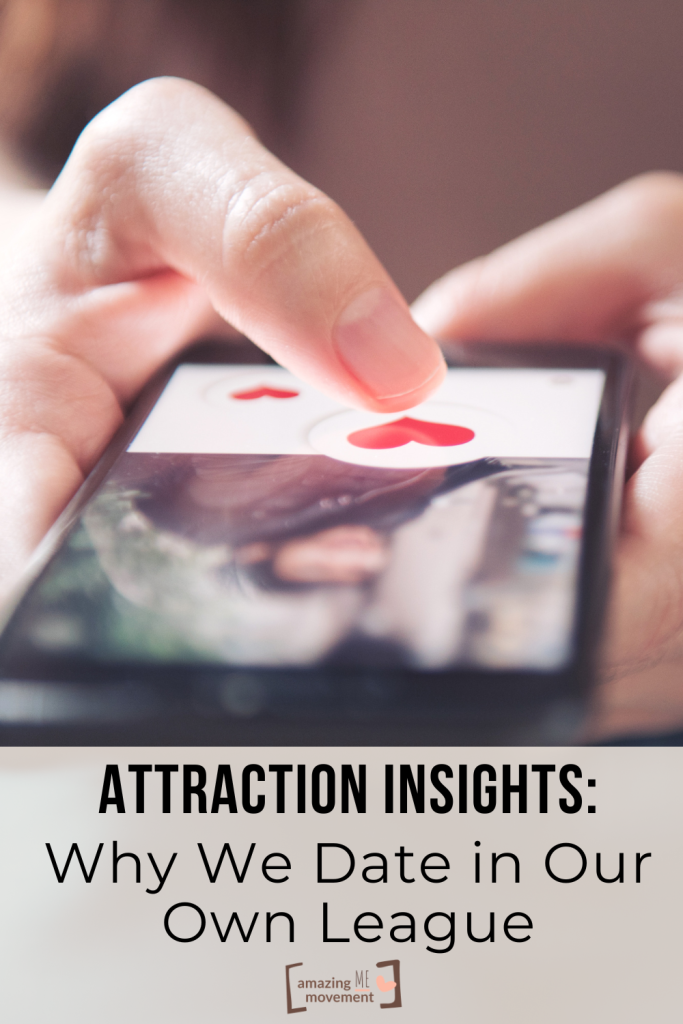Imagine scrolling through a dating app, where you’ve matched with someone who seems perfect. But there’s a nagging thought: Are they out of my league? We’ve all been there, judging potential partners based on attraction and wondering how we measure up.
Attraction plays a pivotal role in our dating choices, often guiding us to select partners we perceive to be in our league. This concept of dating within our “league” raises intriguing questions about self-image and relationship dynamics.
This article delves into the psychology behind why we gravitate towards partners with similar physical attractiveness and self-perception. By understanding these dynamics, we can gain insights into forming more authentic and fulfilling connections.

Understanding Attraction and Its Role in Relationships
Attraction is a complex interplay of physical appearance, personality, and various intangible qualities that draw us toward others. At its core, attraction is both a biological instinct and a personal preference, driven by factors that include facial symmetry, body language, and even pheromones.
Self-attraction ratings refer to how individuals perceive their own level of attractiveness. These self-assessments play a significant role in partner selection, as they often influence whom we feel confident approaching or accepting in our lives.
You might feel emboldened to pursue those you deem equally attractive if you rate yourself highly. Conversely, a lower self-rating may lead you to align your expectations with what you believe to be attainable, impacting your dating choices.
Dating Within Your League: What Does It Mean?
The term “dating within your league” refers to the tendency to seek out romantic partners who have a similar level of attractiveness to oneself. This concept is rooted in self-perception and societal norms, where individuals assess their own worth and search for partners who reflect that perception.
People often choose partners with similar attractiveness levels due to a combination of realistic self-assessment and societal cues. This behavior ensures a balanced dynamic where both parties feel equally valued and appreciated. By opting for someone within their perceived “league,” individuals may reduce the risk of insecurity or imbalance, fostering a more harmonious and stable relationship.

The Science Behind Attraction
A comprehensive review conducted by researchers at the University of Florida sheds light on why we are drawn to partners who match our self-perceived attractiveness. Analyzing over two dozen studies involving nearly 1,300 opposite-sex couples, the research highlights a consistent pattern: individuals tend to date and marry people they view as being in their “league.”
Key Findings
The research reveals that people are generally accurate in assessing their own physical attractiveness, and these self-ratings largely align with how strangers perceive them. This concordance implies that individuals possess a realistic view of their own beauty. As such, they’re likely to select partners who mirror these self-assessments, leading to relationships where both parties perceive each other as equals in terms of attractiveness.

How Self-Perception Influences Your Choices
Self-perception, particularly regarding attractiveness, significantly influences romantic choices. When individuals rate themselves as attractive, they often seek partners who share a similar self-view. This is not just a matter of vanity but rather a subconscious pursuit of balance and validation within the relationship.
Psychological Factors Contributing to Attraction
Several psychological factors contribute to this dynamic:
- Self-Esteem: Individuals with high self-esteem are more likely to pursue partners who match their own attractiveness level. This pursuit helps maintain positive self-regard and satisfaction within the relationship.
- Social Comparison: People often compare themselves to others to gauge their attractiveness. This social comparison influences partner selection, encouraging individuals to align their choices with perceived social norms.
- Reciprocal Liking: The principle of reciprocal liking plays a role, as people tend to be attracted to those who they believe find them attractive in return. This mutual attraction fosters a sense of equality and acceptance within the relationship.
Understanding these psychological underpinnings can offer valuable insights into our dating behaviors, enabling us to make more informed and authentic choices in our romantic lives.

What This Means for Real-Life Relationships
In long-term relationships, the perception of attraction evolves. Initially driven by physical appeal and novelty, these relationships often mature into deeper connections rooted in emotional intimacy and shared experiences. As couples age and navigate life’s challenges together, the significance of physical attractiveness may wane, and mutual respect, understanding, and commitment take center stage.
Over time, partners tend to develop a more realistic understanding of their own attractiveness and that of their partner. This growth in self-awareness often results from shared life experiences, personal development, and a deeper appreciation for qualities beyond physical appearance. As individuals mature, they may find greater satisfaction in the strengths and beauty that truly define their relationship, fostering a profound, enduring bond.
Tips for Building Healthy Relationships
Building a healthy relationship requires self-awareness and mutual appreciation. By focusing on personal growth and valuing your partner’s unique strengths, you can foster a deeper, more meaningful connection.
- Reflect on Self-Perception: Regularly assess how you view your own attractiveness and understand how it influences your relationship choices. Strive for a balanced perspective that values both inner and outer qualities.
- Communicate Openly: Discuss perceptions of attraction with your partner, encouraging a dialogue that emphasizes honesty and mutual understanding.
- Focus on Qualities Beyond Looks: Celebrate attributes like kindness, humor, and resilience, which contribute significantly to a relationship’s success.
- Practice Gratitude: Regularly acknowledge and appreciate the unique qualities your partner brings to the relationship. This practice can enhance emotional intimacy and satisfaction.
- Support Personal Growth: Encourage each other to pursue personal goals and develop new skills, bolstering both individual and relationship growth.
By fostering self-awareness and valuing diverse attributes in your partner, you can build a healthy, fulfilling relationship that thrives on mutual respect and appreciation, transcending the superficialities of attraction.

Conclusion
In exploring the dynamics of attraction, we’ve uncovered why individuals often date within their perceived league, guided by accurate self-perceptions and social norms. The research highlights that while physical attraction initiates many relationships, it’s the deeper understanding of mutual qualities and shared experiences that sustain them. In long-term relationships, self-awareness and a focus on intrinsic values become essential, fostering a bond that transcends mere physical appeal.
Understanding the role of attraction is crucial in forming meaningful relationships. By appreciating both our own and our partners’ unique qualities, we can build connections that are rich in authenticity, respect, and genuine affection.
Explore more of our articles for insights and tips to enrich your relationships!
Being Bored In A Relationship: Are You Bored Or Comfortable?
10 Tips On How To Nurture Mental Health In A Relationship
8 Relationship Possessiveness Red Flags To Look Out For
- 10 Ways to Overcome Procrastination and Get Things Done – 03/03/2025
- How to Overcome Imposter Syndrome and Thrive – 27/02/2025
- 10 Time Management Hacks You’ll Wish You Knew Sooner – 27/02/2025









Leave a Reply